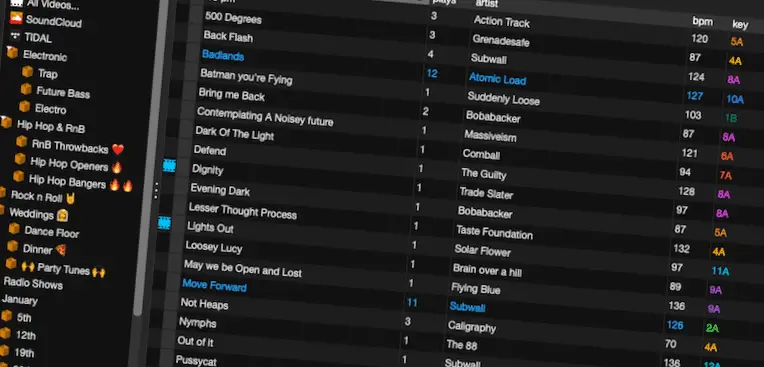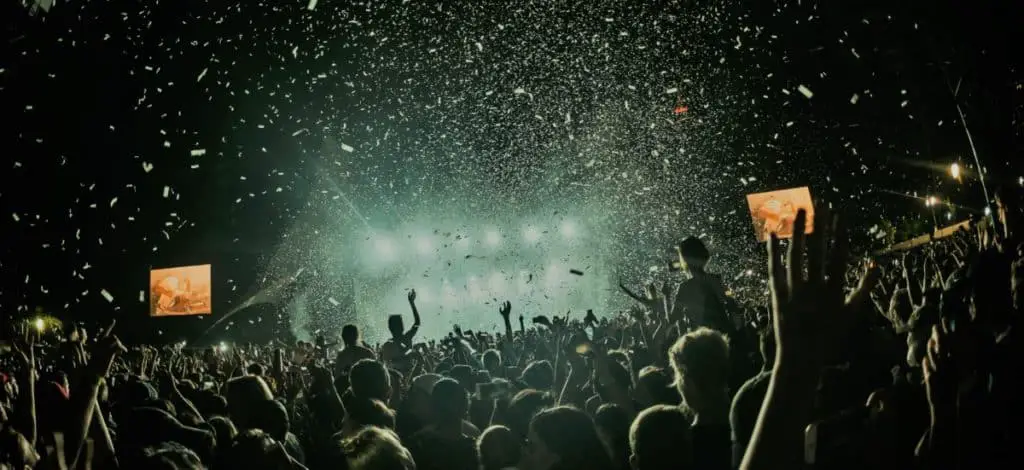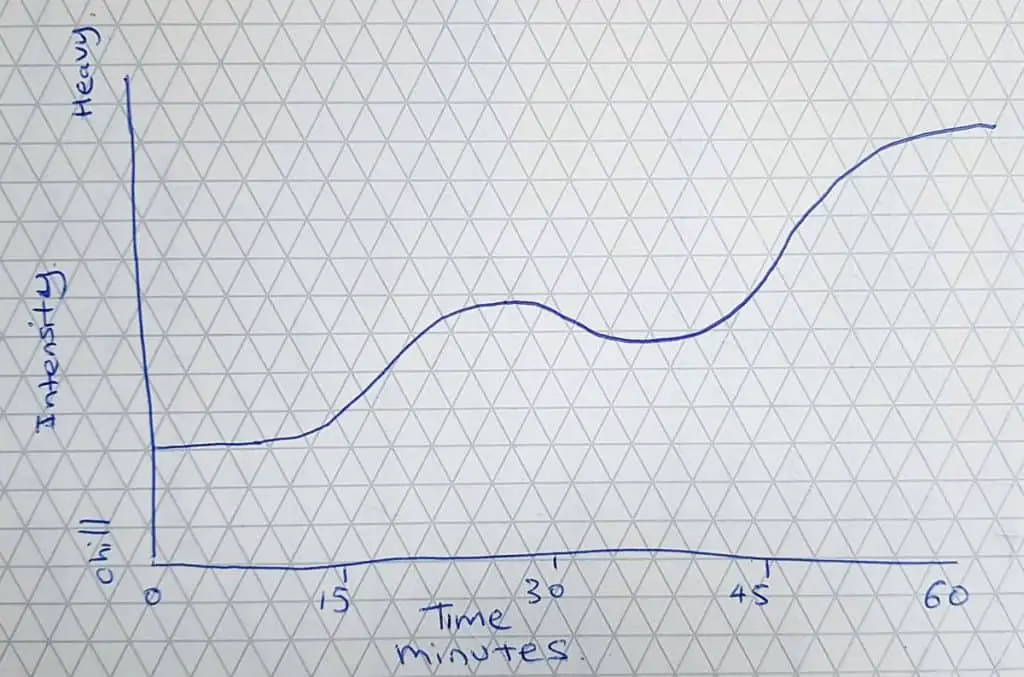
Constructing a set is one of my favourite aspects to DJing, I absolutely love it. It’s one of the parts of DJing that I call the craft and creativity skill of being a DJ. It can be quite daunting to new DJs at first but with some guidance and tips you can easily get going to hone in your skills crafting a DJ set.
How to Construct a DJ Set?
Constructing a DJ set requires knowledge of your music, understanding the purpose of the DJ set, who the audience is, what is the setting or venue and then planning music ahead to form a DJ set. Technical and musical knowledge helps too. DJ software can help organise music to form a DJ set ready for playing live.
Now we’ve detailed the basic outline and framework for putting together and crafting a DJ set or mix. Let’s delve deeper into the top tips for any level of DJ to use to get creative with a DJ set specific to your audience.
Looking to become better at DJing?
#Before Constructing a DJ Set
Target Audience & Genre
Recording a Mix for a Promo Reasons
In your studio you might be recording a mix to then use as a promo to give to clubs, bars and other venues. Your DJ set needs to be tailored to who you’re trying to impress and convince that you’re a sound DJ in terms of skill and track selection.
Planning a DJ set of this kind can be largely different to planning for a club or festival. The mindset is slightly different in terms of creative difference. Focusing on showcasing your skills is essential, but more importantly the genre and style of that genre is key. Adding a bit of your own unique ability and style is great to show off as your own DJ.
You should consider which promoter or club that you’re looking to get a DJ set in. Most likely the club is going to put you early on or really late on, mainly to give room for the headliners. So consider this when you’re constructing your DJ set.
Consider putting together two or three types of mixes. It could likely be that you need to a more chilled version of the genre for warm up DJ sets, and then a more heavy hitting DJ set. Another one could be less targeted and just mix whatever you feel is awesome at the time.
Playing Live in a Club, Bar or Festival
Playing in a club or bar is completely different to mixing at home in a studio. Your job is to get people moving on the dance floor so crafting a DJ set to achieve this is definitely high on your agenda.
Asking “What’s the age of the crowd?” is always a good question, as it can help dictate whether playing older classic banging dance tracks can attract people onto the dance floor and get people energised.
Plan for DJ Set Time (Plus Backup Tracks)
The amount of music tracks is really important to plan for. Knowing the time that you have to play your set, for example 1 hour, 2 hours or longer. You need to be prepared.
My advice for planning for your set time is that you probably need around 12 to 20 tracks planned for 60 minutes, plus another 30 tracks as back up tracks to play. This estimate is based on 5 minutes per track, but some DJs mix really quickly dropping in and out of tracks. Also having extra tracks allows for unforeseen circumstances, for example if the DJ playing before or after you does not show up to play.
Set Time
Warm up set
Warm up sets need to be planned carefully. Mainly to not annoy headlining DJs by stealing their thunder by playing all of the high energy tracks and club bangers. The other point here is that a “warm up set” describes exactly what you need to be doing, and that is warming up the crowd. No need to slam them with energy and heavy bassline music, that’s the job for headliners (unless instructed otherwise by the club manager/label manager).
Slowly introducing the night by playing soft melodies and pulling back the tempo ever so slightly will put you in good stead for DJs playing after you. Do some research and find some great labels in your genre or style and pull together a great DJ set list ready to warm up the crowd.
Headlining
Opposite to putting together a warm up set, being a headliner or a DJ in the main part of the night really changes things up.
Constructing a headliner set needs to be way more pumping, energetic and heaving hitting. When I think of a headlining set I also consider pulling together some chilled but rolling beat ‘filler’ tracks that can give people a break and then ‘build’ back up again to more energised tracks.
There are different types of tracks to categorise in your mind an in your DJ software:
- Chilled tracks
- Tension building tracks
- Rollers or maintaining energy tracks
- Intense peak tracks
Keep it interesting, mix up rollers with baseline heavy tracks and try out your new tracks that are slightly different in style. try out mixing the harmonics of a track and mix in key to change the tone.
A technique is to put all of your related types of tracks into one folder, by that I mean music that’s related by tone, melody and sub genre. You can also split out and categorise your folders but the break up of the set your playing. e.g first 30 mins and 2nd 30 mins.

Know the Type of Gig You’re Playing – Promoter / Label
When DJing in a club environment there’s a chance that the night is sometimes is put on by a record label. I’ve seen DJs that are producers as well, for example Logistics in the Drum & Bass scene. He produces 90% liquid Drum & Bass which is way more chilled vibes and melodic compared to say Jump Up Bassline heavy Drum & Bass.
Logistics has played at label nights such as Fabric at label night for Metalheadz. Logistics tailored his DJ set to be way more darker in tone to suit the style of the label putting on the night at the club. So therefore he has adapted his style to suit the audience.
Know Which DJs Feature on The Lineup
Give yourself a guide on how to craft your DJ set by finding out by whoever is putting on the night which other DJs are playing. It should be easy enough to find out and understand which styles and genres the other DJs play.
Knowing this in conjunction with the time in which you are playing live on the night will put you in good stead. I’ve seen a few times before at clubs where separate DJs throughout the night have played the same tracks and therefore doesn’t seem as unique to the audience. Usually you can get a flavour for for other DJs style and therefore tailor your set to be different.
#Planning & Constructing a DJ Set
Ask Labels, Promoters & Friends for Feedback
Sounds basic and simple, but if you’ve got a good relationship with the promoters that you’re working with then why not get some feedback. This could be from a promo mix CD or link to your SoundCloud. Getting feedback on which tracks they prefer might be the difference of playing a different vibe on the night or adding and taking out a few tracks that might not working in your mix.
Reach out to friends that you know go to clubs or raves regularly and adopt the same process of feedback. This technique could really give you some inspiration and ideas for a DJ set that you are crafting for a specific club night or festival for example.
If you’ve got a podcast or play on a radio show that you mix on for example this is another way to get an idea of the popular tracks.
Get to Know Your Music
Analyse your tracks!
Playing your music and practice mixing for hours is really good for three main reasons. (1) You get to know the structure of your tracks inside out, (2) you find little quirks to set cue points and (3) build up a really good ear for the harmony in which your tracks are in.
I’ve found that this has dramatically helped me to subconsciously know which tracks to select that will definitely go well together in the mix.
Playing around with your music to come up with your favourite mixes is also a great way to show off your style as a DJ.
In the case that you decide on a DJ set either live studio recording or club environment you can use this skill to blend in tracks that are getting the crowd going. Sometimes it simply comes down to reading the crowd to see what they’re reacting and dancing to.
Select Music that Phrase Matches
In order to achieve a great DJ set finding tracks that mix well together. Matching phrases can help support a DJ mix to sound smooth and blended so well together.
Certain genres of music mix well together which is great. However if you have a mixture of sub-genres or different genre styles altogether then phrase matching is more important when selecting music for your DJ set.
This is why knowing your music is so important so that you either intuitively know where the good sections (phrases) of song to mix in. Or you’ve set your cue points in the DJ software, more on cue points shortly.
You can learn more about phrases and beats here.
Harmonics – Mix Tracks in Key
Planning your set has become dramatically easier and way more efficiently with the use of DJ software. Music tracks carry meta data which can be presented on DJ software to show the key of each track, therefore giving you an amazing indication of which songs will mix well together.
Rekordbox is really good for this and has an amazing ‘Related’ tracks feature. Select an existing track and you can see on the right hand side of the DJ software related ‘in key’ tracks are provided for you to select. DJing is a doddle these days in comparison to DJing vinyl.
Set Cue Points
Setting cue points can really take away the pressure of your first few performances. It gives you that chance to quickly cue up your tracks and the get the BPMs matched up ready for a sexy transition from track to track.
Cue points on DJ software are your friends so in your practice and planning sessions, get them all set up ready for your live performance.
Draw a Journey of Your DJ Set

Sounds strange, it can help you out if you’re a visual person when planning your DJ set. I can relate this to producing music, I sometimes draw an outline of how long I want each of the sections to be and the intensity throughout.
Think of a graph, Y axis being intensity and X axis being time of your DJ set. You could start off with some real intense tracks, mellow it out again and then finish with a high. Some DJs start chilled and flowing, then build up intensity until the finish. Try it out, it might help you visualise how you want your DJ set to pan out.
Performance Style DJ Set – Using Effects
Another angle that you can take is more of a performance style to your DJing. Adding in loads of effects such as looping, echo or delay can give feelings of suspense or mellowness depending on the tracks your playing.
For example DJ EZ who plays classic Garage, house and speed Garage cuts in effects all throughout his DJ sets giving a great performance.
Play Remixes to Keep it Fresh
To get the crowd really going a pumped up and peak interest, add in some remixes of popular songs. You can get hold of some mainstream pop songs that are remixed into electronic music, such as House, Techno, Garage or Drum & Bass.
Mashups (Live & Create Your Own)
Similar to adding remixes to your DJ set, mashups are a really creative way to make you stand out as a DJ. It allows you to show that you’re not just a standard DJ and that you have some flair.
A technique can be to use an acapella track, which is a vocal of a popular song. Then mix it over another track, either an instrumental or a section of a track that goes really well with the vocals.
Another technique is to make your own mashup for extra creativeness and originality. Get hold of Garageband, if you have a Macbook I think it’s free, or a version of Ableton. You can download an instrumental track and add an acapella, once you’ve beat matched the two, bounce down the final track. A great addition to your DJ sets.
Multi-Genre Mixing
Cross mixing different genres is a great way to get the crowd going too. For example Hip Hop and Drum & Bass is an easy way to beat match together as Hip Hop is pretty much half time of 174 BPM.
There are some tracks in Drum & Bass that start off or have at least one section that contains a Hip Hop beat, so it’s very easy to build in a few different tracks of each into your DJ set.
Organise Music by Folder in Your DJ Software
Create folders for type of music and even sub-genre. This will allow you to very quickly access the tracks that you need to either select while you’re DJing or use to organise specific DJ sets.
Create folders for times to play music within a specific DJ Set. By this I mean if you’ve got a 1 hour set then consider grouping together tracks for the first 20 minutes and then the 2nd and 3rd 20 minute segments. Another angle you could take is group tracks for a specific venue you are going to play by related music melody, dark/soft vibe, rhythm or sub-genre. This technique will allow you to quickly select the right track throughout your set.
The lazy option here is to have one folder for all the music for the DJ set, simply use as a rough guide though. I think this is ok if you’re just DJing from a blank canvas and going with the flow.
Use Related Tracks Section (Rekordbox)
If you have Rekordbox then use and check out the related tracks section on the software. It’s a really great way to get inspiration for related tracks in key especially beneficial if you’re looking to mix tracks in key.
Just Mix! Improvise DJing
As mentoned above, if you’re going down the route of having one folder in your DJ software then that’s fine too.
It’s a real skill to read the crowd or simply use your intuition to put together an impromptu mix in front of a live audience. My advice would be to practice this at low key venues mainly to get some experience first before playing in front of bigger crowds.
Another point to consider with this is that if you’re a producer and playing at a label night you will want to look to play your own style to stand out and back up any of your own releases.
Plan & Pre-load Samples
Samples can really add an extra dynamic to your DJ sets. Get prepared, save and organise your samples into a specific folder for a venue that you’re going to play.
With any live performance getting prepared is key to success and will take the pressure off.
Practice points in your DJ set which tracks would go particularly well with certain samples. I’ve found in the past that you need to practice using samples, e.g. from your DJ controller, will allow you to get used to where to input samples and also get used to the equipment you’re using.
#After Your DJ Set
Ask for Feedback After Your DJ Set (If you’re a resident DJ for example)
Similar to the previous point above, but this could really help you get a steer in the right direction when you’re starting out as a DJ.
You can get a feel from the club promoters or club goers what they thought went really well in your set and maybe what didn’t.
It doesn’t matter, either way you get to build up some knowledge and experience of what tracks worked and what didn’t for specific gigs that you played at.
Related Questions
How long should a DJ set be?
A DJ set typically lasts 60 minutes when a club DJ is playing at a electronic dance event. In some cases DJs can play 2 hours and maybe even more. A DJ set can also be 30 minutes long and used a promotional DJ mix, also known as a mini-mix.
How many songs are in a DJ set per hour?
Playing each song for 3 minutes it’s possible to mix and transition through 20 songs. Although different genres and styles of DJing may alter how many songs are played within an hour.
